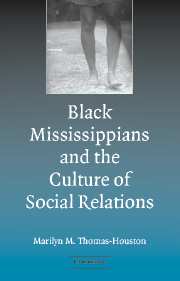Book contents
- Frontmatter
- Contents
- Preface
- Acknowledgments
- Introduction
- PART ONE THE CULTURAL HISTORY AND SOCIAL STRUCTURE OF THE REGION
- PART TWO SOCIAL CONSCIOUSNESS, SOCIAL ACTION
- PART THREE CONSTRUCTION OF AN INTRARACIAL IDENTITY
- 5 “What's Race Got To Do With It?”
- 6 It's a White “Thang”: Ethnic Identifiers and the Loss of Cultural Codes
- 7 The Final (Af)front: Space and the Black Public Sphere
- Conclusion
- Appendix A Lafayette County Population Chart
- Appendix B Proclamation Honoring Ole Miss Demonstrators
- Appendix C Chancellor's Statement of Commendation
- Appendix D Speech by Susie Marshall for Second Baptist Church Honoring Rev. Blind Jim Ivy
- Appendix E Susie Marshall's Unpublished Draft of Freedman Town Marker Dedication Speech Recounting July 4, 1867, Speech of Oxford Ex-slave
- Bibliography
- Index
7 - The Final (Af)front: Space and the Black Public Sphere
Published online by Cambridge University Press: 23 December 2009
- Frontmatter
- Contents
- Preface
- Acknowledgments
- Introduction
- PART ONE THE CULTURAL HISTORY AND SOCIAL STRUCTURE OF THE REGION
- PART TWO SOCIAL CONSCIOUSNESS, SOCIAL ACTION
- PART THREE CONSTRUCTION OF AN INTRARACIAL IDENTITY
- 5 “What's Race Got To Do With It?”
- 6 It's a White “Thang”: Ethnic Identifiers and the Loss of Cultural Codes
- 7 The Final (Af)front: Space and the Black Public Sphere
- Conclusion
- Appendix A Lafayette County Population Chart
- Appendix B Proclamation Honoring Ole Miss Demonstrators
- Appendix C Chancellor's Statement of Commendation
- Appendix D Speech by Susie Marshall for Second Baptist Church Honoring Rev. Blind Jim Ivy
- Appendix E Susie Marshall's Unpublished Draft of Freedman Town Marker Dedication Speech Recounting July 4, 1867, Speech of Oxford Ex-slave
- Bibliography
- Index
Summary
Before examining the function of the Black public sphere and its relationship to use of space by Blacks in Oxford/Lafayette County, I want to address more generally the practices of subordinate groups for instituting change in stratified societies. This discussion sheds light on examples of getting over provided in previous chapters. The chapter goes on to describe what constitutes the Black public sphere in Oxford/Lafayette County and then addresses the use-of-space problems that become impediments to the operation of that sphere.
The general concern of this chapter is social change. Social scientists recognize that social change is often brought about through two distinct methods – either as a result of the deliberate attempt of a group to solve some perceived problem or as a result of forced subordination during especially intense contact between two societies. Despite this awareness, we rarely acknowledge that, in addition to the expected changes, unintended consequences often accompany these two methods. In stratified systems, the model for change is influenced and constructed by the ideology of the dominant society. This is largely the result of its control over the necessary resources and the means of production – both economic and cultural. The dominant society constructs the major institutions, such as churches, schools, and newspapers. These institutions in turn legitimate the position of the dominant society. They enforce and maintain changes made through political and social repression.
- Type
- Chapter
- Information
- 'Stony the Road' to ChangeBlack Mississippians and the Culture of Social Relations, pp. 164 - 175Publisher: Cambridge University PressPrint publication year: 2004

